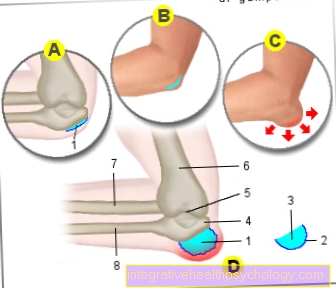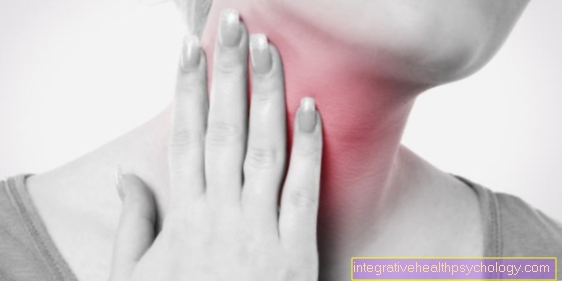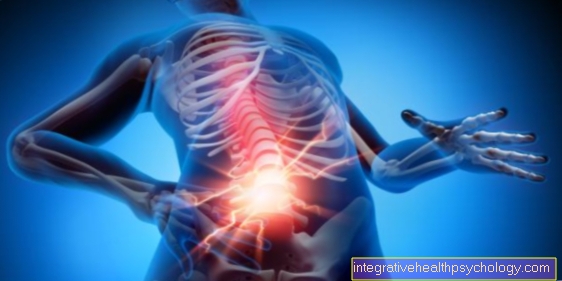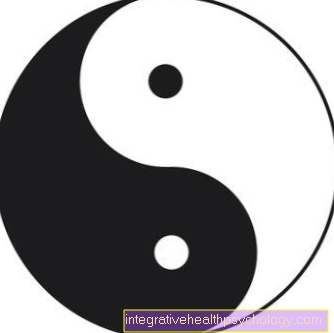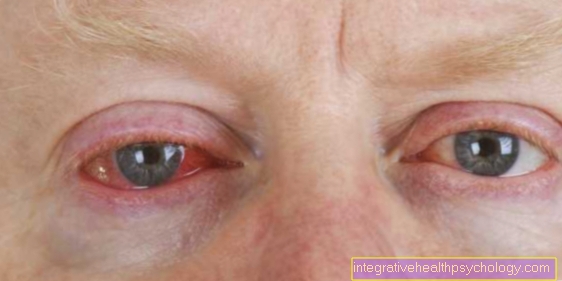Pain in the outer thigh
introduction
Pain in the outer thigh is often caused by muscular tension and is not uncommon. Running sports such as football, handball or endurance running can lead to problems. Athletes who increase their training too quickly, do not warm up their muscles and tendons before exercise or do not stretch sufficiently after exercise, often experience pain.
Obesity also plays an important role in the development of pain in the outer thigh by overstressing the bones and muscles.
In most cases, the pain can be felt when moving or exercising, and it can extend into the knee.

Causes of Outer Thigh Pain
Outer thigh pain can have many different causes.
-
Tensioning of the iliotibial tract (tendon fibers of two hip muscles, connecting the outer hip and knee): The tension can occur on the one hand due to misalignments, for example knock knees, and on the other hand due to incorrect loads on both sides or on one side.
-
Meralgia paraesthetica: The nerve that supplies the outer thigh becomes pinched, causing pain and numbness in the outer thigh.
-
Diseases of the hip joint: This can lead to pain due to osteoarthritis of the hip joint.
-
Trochenteric bursitis: This is an inflammation of a bursa that is attached to the upper thigh bone and which can become inflamed after a fall, for example.
Bursitis of the hip as the cause
The bursitis of the hip, also known as trochanteric bursitis, describes an inflammation of the bursae, which is located on the thigh bone. The upper end of the thigh bone has a protruding bone over which the iliotibial band slides. The iliotibial band is a strong stabilizing ligament that connects the hip and knee. To prevent the tract from rubbing against the protruding bone, a bursa is placed in between.
This bursa can become inflamed after falls, improper and excessive stress (sport, overweight) and cause movement-dependent pain in the outer hip.
For more information, read on: Trochenteric bursitis.
The snapping hip as the cause
A snapping hip is also known as a coxa saltans. Young women are mostly affected by the snapping hip. When walking, there is a palpable and possibly audible snap when the iliotibial band glides over the upper thigh bone. The iliotibial band is a ligament made up of tendon fibers from various muscles. It gives the thigh bone stability and protects against fractures.
As the disease progresses, the bursa between the ligament and the bone may become inflamed and painful. The therapy consists of a physiotherapeutic treatment and pain treatment with medication. If the pain persists, surgery may be necessary.
More information on the topic snapping hip get here.
The L2 syndrome as the cause
L2 syndrome is rare and can result from a herniated disc of the lumbar spine or a prolapse of the disc. Pressure on the nerves can lead to pain in the supply area of the spinal cord nerve lumbar spine 2 (L2). In addition to the pain, numbness and decreased strength may also occur.
If there is any suspicion, a CT or MRI should be performed as soon as possible to prevent further nerve damage.
Find out all about the topic here: Cause of pain in the legs.
The accompanying symptoms
The numbness as a symptom
The numbness of the skin indicates nerve irritation or damage. The outer thigh is supplied by the so-called lateral cutaneous nerve femoris. If this is narrowed in its course, there is pain and numbness.
This nerve irritation is also known as meralgia paraesthetica or colloquially as a jeans lesion. The constriction of the nerve can be triggered by an increase in pressure in the abdomen during pregnancy or if you are overweight. External compression from a belt, waistband or corset can also cause these symptoms.
If the cause is avoided or eliminated, the symptoms usually improve spontaneously.
More information on the topic Meralgia paraesthetica you'll find here.
A burning sensation as a symptom
A burning sensation also indicates nerve irritation or damage. On the outer thigh, the burning sensation can be caused by a narrowing of what is known as the lateral femoral cutaneous nerve. This nerve supplies the area on the outer thigh with sensitivity. This condition is also known as meralgia paraesthetica.
Polyneuropathies, which are particularly common in diabetics or long-term alcoholics, can cause a burning sensation in the outer thigh. This results in nerve damage, whereby the disease progresses slowly and usually begins with sensory disorders such as burning, tingling or numbness in the feet.
Also read the article: Polyneuropathy.
The thigh cramp as a symptom
A spasm in the outer thigh muscles or the outer gluteal muscles can cause pain. Most of them start very suddenly and stop after a few seconds to minutes.
One cause of cramps in the thigh, for example, can be an overload of the muscles. A lack of magnesium can also cause muscle cramps. This can be caused by an unbalanced diet or by drugs that ensure that more magnesium is excreted. Fat reducers, so-called statins, can also cause thigh pain.
If statins are causing the cramps, it is important to stop using them. Statins are drugs that are often used when blood fat levels are high. One of the side effects is muscle pain and cramps. In the worst case, skeletal muscle breakdown (so-called rhabdomyolysis) and acute kidney failure can occur.
Can that also be a thrombosis?
A thrombosis is a vascular occlusion caused by a blood clot in a deep vein in the leg. This causes pain where the vessel is closed. If a vessel near the outer thigh is affected, the pain can also be felt there.
In addition, there may be swelling of the leg, a blue-livid discoloration, overheating and a feeling of heaviness in the leg. If there is a suspicion of a thrombosis, it should be excluded or confirmed by an ultrasound examination and treated early.
Find out more about the topic here: deep vein thrombosis.
Appointment with ?

I would be happy to advise you!
Who am I?
My name is dr. Nicolas Gumpert. I am a specialist in orthopedics and the founder of .
Various television programs and print media report regularly about my work. On HR television you can see me every 6 weeks live on "Hallo Hessen".
But now enough is indicated ;-)
In order to be able to treat successfully in orthopedics, a thorough examination, diagnosis and a medical history are required.
In our very economic world in particular, there is too little time to thoroughly grasp the complex diseases of orthopedics and thus initiate targeted treatment.
I don't want to join the ranks of "quick knife pullers".
The aim of any treatment is treatment without surgery.
Which therapy achieves the best results in the long term can only be determined after looking at all of the information (Examination, X-ray, ultrasound, MRI, etc.) be assessed.
You will find me:
- Lumedis - orthopedic surgeons
Kaiserstrasse 14
60311 Frankfurt am Main
You can make an appointment here.
Unfortunately, it is currently only possible to make an appointment with private health insurers. I hope for your understanding!
For more information about myself, see Lumedis - Orthopedists.
When does the pain occur?
Pain when walking
Outer thigh pain can be experienced by runners. Typically, these pains arise in athletes after very heavy use, i.e. after extremely long running distances, but also with unusual stress. An experienced long-distance runner can develop pain even after only moderately intensive sprint training, as he is not used to it. Even those returning after the winter break or inexperienced people who start their first training with too much ambition can develop these complaints.
Where does the pain come from? On the outside of the thigh is a tendon plate called the iliotibial band. This tendon pulls from the gluteus muscle (Gluteus Maximus), which attaches to the iliac bone, to the upper end of the tibia. Both the hip and the knee can be bent via this fiber strand. Therefore, when jogging, this pull is subjected to great stress, the tendon becomes irritated and then causes pain in the outer thigh.
Tendonitis of the thigh can develop, which manifests itself in movement-dependent, usually sharp pain.
Another function of the Iliotibialis tract is to reduce the bending load on the thighbone by additionally fixing the thigh. This strain is very high, especially when running, since with every step a multiple of the body weight acts on the joints and the tendon is considerably irritated. Athletes with bow legs are particularly affected by these complaints.
This so-called "runner's knee" or "tractus syndrome" can be remedied by taking breaks in sports, as well as better dosed stress, but also special stretching exercises.
Pain when lying down
Especially in the morning and before getting up, people with rheumatic complaints suffer from pain in the hip area, which can often radiate to the outside of the thigh. People with Bechterew's disease are particularly affected in the area of the intestinal sacrum. This is a rheumatic disease that particularly affects the pelvis and vertebral joints. It mainly affects men, although the disease usually first becomes apparent in young adulthood.
Typical of all rheumatic complaints are, on the one hand, the morning stiffness, which, however, decreases during the day. On the one hand, painkillers such as aspirin or ibuprofen help against the symptoms of rheumatic diseases, which not only work against the pain but also against the inflammatory process. This is how these pain relievers work, because of this effect too Non-steroidal anti-inflammatory drugs (NSAIDs), both causally and symptomatically against rheumatic complaints.
Another treatment option are cortisone preparations, which also reduce inflammatory reactions. However, when used over the long term, cortisone causes considerable side effects, such as fat deposits. Therefore, cortisone preparations are either used in low doses or as shock therapy, i.e. for a short time but then in very high doses. Another approach in rheumatism treatment is immunosuppressants, i.e. drugs that suppress the body's own immune system.
Find out all about the topic here: Rheumatism.



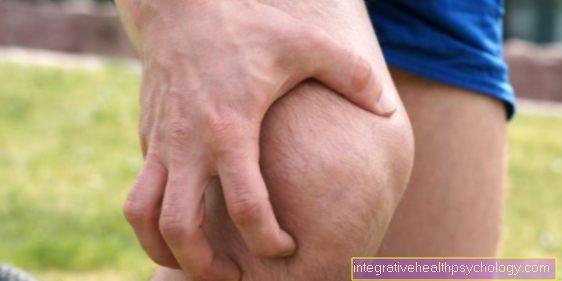







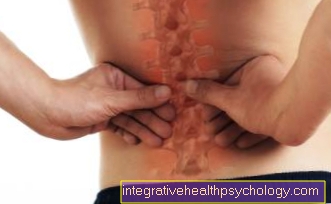
.jpg)






